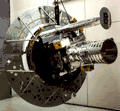Solar Mesosphere Explorer
The Solar Mesosphere Explorer (also known as Explorer 64) was a U.S. uncrewed spacecraft to investigate the processes that create and destroy ozone in Earth's upper atmosphere. The mesosphere is a layer of the atmosphere extending from the top of the stratosphere to an altitude of about 80 km (50 mi). The spacecraft carried five instruments to measure ozone, water vapor, and incoming solar radiation.
 | |
| Mission type | Earth observation |
|---|---|
| Operator | NASA |
| COSPAR ID | 1981-100A |
| SATCAT no. | 12887 |
| Mission duration | ~7 years |
| Spacecraft properties | |
| Manufacturer | Jet Propulsion Laboratory |
| Launch mass | 437 kg (963 lb) |
| Start of mission | |
| Launch date | October 6, 1981, 11:27 UTC |
| Rocket | Delta 2310 |
| Launch site | Vandenberg AFB SLC-2W |
| Orbital parameters | |
| Reference system | Geocentric |
| Regime | Low Earth |
| Perigee altitude | 535.0 kilometers (332.4 mi) |
| Apogee altitude | 551.0 kilometers (342.4 mi) |
| Inclination | 97.5589 degrees |
| Period | 95.50 minutes |
| RAAN | 138.8452 degrees |
| Argument of perigee | 259.5734 degrees |
| Mean anomaly | 100.6126 degrees |
| Mean motion | 16.36783794 |
| Epoch | 5 March 1991, 04:02:01 UTC |
| Revolution no. | 205 |
| Instruments | |
| Ultraviolet ozone spectrometer 1.27 micrometer spectrometer nitrogen dioxide spectrometer four-channel infrared radiometer solar ultraviolet monitor solar proton alarm detector | |
Launched on October 6, 1981, on a Delta rocket from Vandenberg Air Force Base, in California, the satellite returned data until April 4, 1989. The spacecraft reentered Earth's atmosphere on March 5, 1991.
Managed for NASA by the Jet Propulsion Laboratory, the Solar Mesosphere Explorer was built by Ball Space Systems and operated by the Laboratory for Atmospheric and Space Physics of the University of Colorado where one hundred undergraduate and graduate students were involved.[1]
- Mass: 437 kilograms (963 pounds)
- Power: Solar panels which charged NiCad batteries
- Configuration: Cylinder 1.25 meter (4.1 ft) diameter by 1.7 meter (5.6 ft) high
- Science instruments: Ultraviolet ozone spectrometer, 1.27 micrometre spectrometer, nitrogen dioxide spectrometer, four-channel infrared radiometer, solar ultraviolet monitor, solar proton alarm detector
References
- SME: Solar Mesosphere Explorer, University of Colorado at Boulder, "Archived copy". Archived from the original on 2007-07-13. Retrieved 2007-09-27.CS1 maint: archived copy as title (link)
.png.webp)